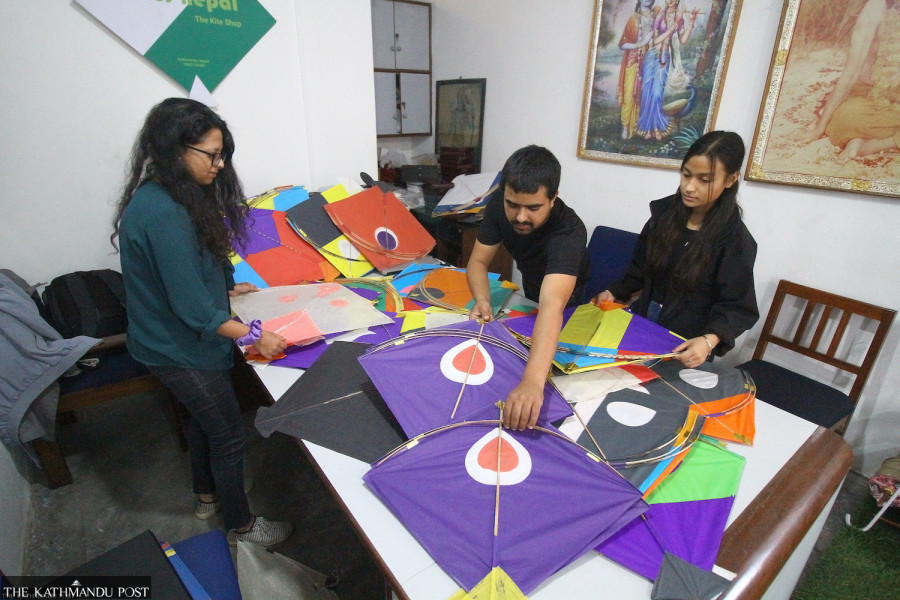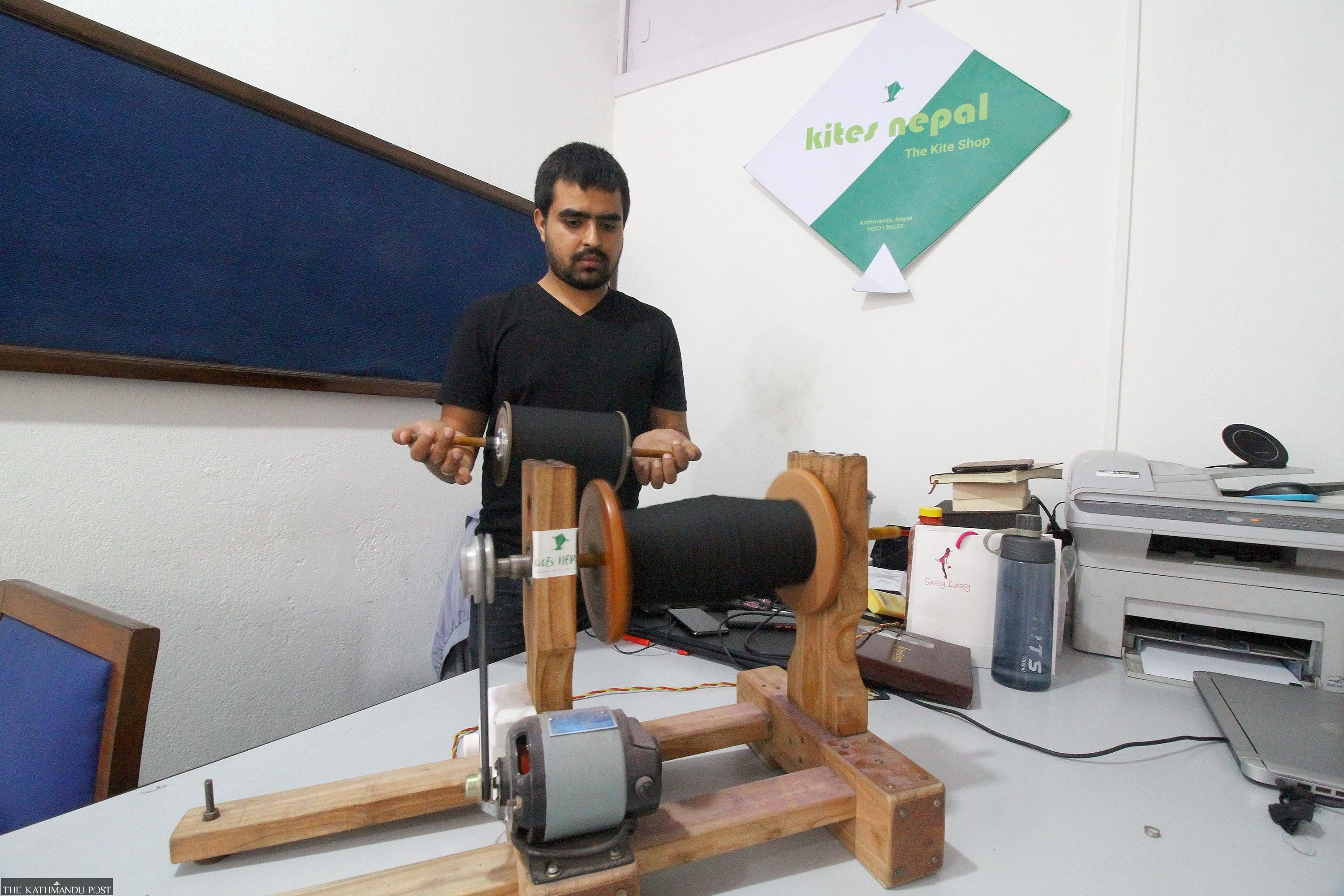Culture & Lifestyle
Rediscovering the joy of flying kites
Kite flying during the time of Dashain is no longer as popular as it once was, but one startup is hoping to change that.
Pinki Sris Rana
Growing up in Kathmandu’s Baluwatar, Bikal Chalaugain’s favourite thing to do during Dashain was flying kites. Back then, Baluwatar wasn’t as urbanised as it is today, says Chaulagain.
“Twenty years ago, the concrete buildings that you see today were just swathes of paddy fields. And a few weeks before Dashain, one could see people—young and old—from the area flying kites in the fields. I have many fond memories flying kites in the fields of Baluwatar,” says Chaulagain. “When we were young, once you started seeing kites soaring in the sky, you knew that Dashain was near.”
Nearly two decades later, things have changed. Like everywhere else in the city, concrete buildings have sprung up in Baluwatar’s once open fields. And the culture of flying kites around Dashain has all but disappeared. Kathmandu’s relationship with flying kites has changed.
“Even though Dashain is just three weeks away, you only see a handful of kites soaring in Kathmandu’s skies,” says Chaulagain.
His childhood love for flying kites and a nostalgia for the way Kathmandu once celebrated Dashain led Chaulagain to start his business Kites Nepal.
“The idea of setting up this business came to me last year. The months of lockdowns had me wanting to take part in outdoor activities. Since Dashain was approaching, I decided to go to Kalimati to buy kites and the necessary gears,” says Chaulagain. “I was so surprised to see vendors selling low-quality kites and gears at exorbitant prices. I was quite shocked to see that while prices of kites and gears have gone up, the quality of materials seems to have declined. That is when I decided to start my own business. The business is my attempt to make quality kites and gears accessible to people, and I hope that this would once again have people finding joy in flying kites during Dashain.”
But why is it that kites are exclusively flown during the time of Dashain?
“Back when the majority of people in the Valley were farmers, people believed that flying kites is a signal to Indra, the god of rain, to stop the rain as the farmers get done planting crops by Dashain,” says Nirmal Man Tuladhar, a cultural heritage expert and professor of linguistics at Tribhuvan University. “It is also believed that flying kites during an auspicious time like Dashain brings happiness, good health, and peace in the family. Some also believe that flying kites is a way to communicate with deceased family members and show them the way to heaven.”
Apart from the social and cultural significance of flying kites, the time of Dashain is also when the weather of the Valley is the most ideal for outdoor activity.
“This time of the year marks the end of monsoon, and the Valley sees clear blue skies and gentle breeze. These weather conditions make it perfect for kite flying,” says Tuladhar. “In an agrarian Kathmandu Valley, this used to be the period when families finally had free time after months of working in the fields. As the period also marks the start of the festive season, flying kites was a fun activity for families to indulge in.”
Tuladhar, who grew up in Asan, fondly remembers how the neighbourhood skies would get strewn with kites during Dashain season.
“It used to be very challenging flying kites in Asan during Dashain because there used to be just too many kites up in the sky. That’s how
popular flying kites were back then,” says Tuladhar.
The decline of the culture of flying kites, say cultural observers, was a gradual one.
“As children, we flew kites from the rooftops of our houses. Back in those days, rooftops didn’t use to be fenced, and it was quite common for children to fall over buildings while being engrossed in flying kites,” says Tuladhar. “So naturally parents preferred children to either fly kites in open fields or play indoors.”
As Kathmandu urbanised and open fields began shrinking, the only place for people to fly kites was from rooftops.
And then came video and PC games.
“After the introduction of video and PC games, children no longer found flying kites entertaining,” says Chaulagain. “By the time I was in grade seven, I was so transfixed by video and PC games that I had stopped going out to fly kites.”
Given that Kathmandu has become more urbanised than ever and its residents busier than ever, Chaulagain is aware that getting people to fly kites again is not an easy task.
“Nostalgia is a strong emotion and for many of us who grew up flying kites, we all remember the joy we derived from the activity. So I am hopeful,” says Chaulagain.
Initially, Chaulagain wanted Kites Nepal to manufacture its own kites and gears. His aim was to make kites from Nepali paper, but he soon realised it wasn’t a practical idea.
“To make a kit using the traditional method takes around 20 minutes, and that aspect made mass-producing such kites time consuming and financially costly, and a machine that makes such kites cost around Rs one million,” says Chaulagain.

Instead, they decided to focus on importing quality kites and lattais directly from manufacturers in India.
“Traditionally in Nepal, kite flyers use lattais to cut strings of other flying kites, and local lattais are designed to do just that. But lattais from other countries don’t have that feature,” says Tuladhar.
Having grown up flying kites, Chaulagain says he prefers to cut strings of flying kites using local lattais.
“We also sell local lattais so that those who want to get into kite fights can get the tools they need to do so,” says Chaulagain.
Apart from lattais, strings are also a very important part of kite flying, and for Nepali kite fights, manja is the most preferred string.
“Traditionally, manja strings are made by coating regular strings with a paste of glass dust, which helps cut the thread of other flying kites,” says Tuladhar.
To market its products, Kites Nepal relies solely on social media.
“Thanks to social media, startups like us can market our products without having to invest heavily on advertisements,” says Chaulagain. “Customers can place orders via our social media pages and we also offer home delivery service.”
Since kites are exclusively flown during the month of Dashain, kites sellers like Kites Nepal have a one- or two-month window to sell their products.
“Being a seasonal business comes with its own set of challenges. But selling kites isn’t the only thing we see ourselves doing,” says Chaulagain. “We are planning to organise kite-flying (changa chait) festivals and workshops for young children on making and flying kites. The aim is to get people to rediscover the joys of flying kites.”




 12.12°C Kathmandu
12.12°C Kathmandu















